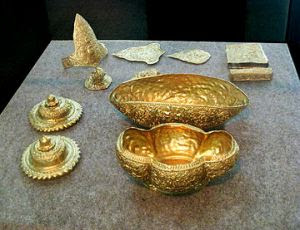Heritage Khasanah Gold Indonesia in National Museum
National Museum Jakarta Indonesia storing a variety of historical relics. One of the most special relics are a number of gold displayed neatly in a khasanah of gold on the fourth floor of the building.
Giving the name of khasanah itself adapted to the material, shape, and function of the object. Gold is a precious metal that is resistant to corrosion and most chemicals can not affect.
The results of the archaeological discovery of gold on display in the khasanah of gold is mostly derived from the Hindu Budha, in the 8th century AD to the 15th century AD.
Wonoboyo village, Klaten, Central Java and Muteran village, Mojokerto, East Java, was the origin of the most amazing discovery. This is possible because in those days many traders from Arabia, China and the Malay Peninsula came with the gold.
The discovery of gold in Wonoboyo generate at least 35 kg of gold, including the 6396 gold pieces "piloncito" (coins during the Majapahit, Century 11-13 AD) and 600 silver coins. All are stored in four Chinese urns olive green color comes from the Tang Dynasty (618-907 AD) and a large round box made of bronze at a depth of approximately 2.7 meters.
Some other form of gold as jewelry, ceremonial equipment, and parts of the keris. One form of the famous jewelry in the future it is pectoral. Shaped like a crescent moon, filled with floral motifs. Judging from the shape, it is estimated the jewelry is worn by men as pectoral.
There is also a jewelry that is used as a chelating shoulder with pearl motifs such as the composition of the fried-shaped flowers, tendrils and delicate beading. Form describing the nature and the tendrils of the fertile island of Java. (matortor)









Post a Comment